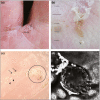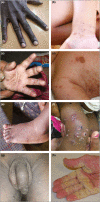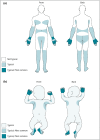The 2020 International Alliance for the Control of Scabies Consensus Criteria for the Diagnosis of Scabies
- PMID: 32034956
- PMCID: PMC7687112
- DOI: 10.1111/bjd.18943
The 2020 International Alliance for the Control of Scabies Consensus Criteria for the Diagnosis of Scabies
Abstract
Background: Scabies is a common parasitic skin condition that causes considerable morbidity globally. Clinical and epidemiological research for scabies has been limited by a lack of standardization of diagnostic methods.
Objectives: To develop consensus criteria for the diagnosis of common scabies that could be implemented in a variety of settings.
Methods: Consensus diagnostic criteria were developed through a Delphi study with international experts. Detailed recommendations were collected from the expert panel to define the criteria features and guide their implementation. These comments were then combined with a comprehensive review of the available literature and the opinion of an expanded group of international experts to develop detailed, evidence-based definitions and diagnostic methods.
Results: The 2020 International Alliance for the Control of Scabies (IACS) Consensus Criteria for the Diagnosis of Scabies include three levels of diagnostic certainty and eight subcategories. Confirmed scabies (level A) requires direct visualization of the mite or its products. Clinical scabies (level B) and suspected scabies (level C) rely on clinical assessment of signs and symptoms. Evidence-based, consensus methods for microscopy, visualization and clinical symptoms and signs were developed, along with a media library.
Conclusions: The 2020 IACS Criteria represent a pragmatic yet robust set of diagnostic features and methods. The criteria may be implemented in a range of research, public health and clinical settings by selecting the appropriate diagnostic levels and subcategories. These criteria may provide greater consistency and standardization for scabies diagnosis. Validation studies, development of training materials and development of survey methods are now required. What is already known about this topic? The diagnosis of scabies is limited by the lack of accurate, objective tests. Microscopy of skin scrapings can confirm the diagnosis, but it is insensitive, invasive and often impractical. Diagnosis usually relies on clinical assessment, although visualization using dermoscopy is becoming increasingly common. These diagnostic methods have not been standardized, hampering the interpretation of findings from clinical research and epidemiological surveys, and the development of scabies control strategies. What does this study add? International consensus diagnostic criteria for common scabies were developed through a Delphi study with global experts. The 2020 International Alliance for the Control of Scabies (IACS) Criteria categorize diagnosis at three levels of diagnostic certainty (confirmed, clinical and suspected scabies) and eight subcategories, and can be adapted to a range of research and public health settings. Detailed definitions and figures are included to aid training and implementation. The 2020 IACS Criteria may facilitate the standardization of scabies diagnosis.
© 2020 The Authors. British Journal of Dermatology published by John Wiley & Sons Ltd on behalf of British Association of Dermatologists.
Figures




References
-
- Mellanby K. The development of symptoms, parasitic infection and immunity in human scabies. Parasitology 2009; 35:197–206.
-
- Heilesen B. Studies on Acarus scabiei and Scabies . Acta Derm Venereol 1946; 26:370.
-
- GBD 2015 Disease and Injury Incidence and Prevalence Collaborators . Global, regional, and national incidence, prevalence, and years lived with disability for 310 diseases and injuries, 1990–2015: a systematic analysis for the Global Burden of Disease Study 2015. Lancet 2016; 388:1545–602. - PMC - PubMed
-
- GBD 2015 Disease and Injury Incidence and Prevalence Collaborators . Global, regional, and national incidence, prevalence, and years lived with disability for 328 diseases and injuries for 195 countries, 1990–2016: a systematic analysis for the Global Burden of Disease Study 2016. Lancet 2017; 390:1211–59. - PMC - PubMed

